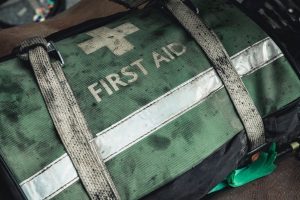Is my son depressed, or just lazy?

“Is my son depressed, or just lazy?” I have been asked this question by many parents with sons in middle and high school. In fact, it’s often the question that brings a family in for an initial appointment with a psychotherapist. Although I mostly hear from mothers worried about their sons, my thoughts apply well to fathers and daughters, too.
A mother will express concern that her son has been withdrawn, holed up in his room, eyes glued to his Xbox. He seems more irritable. Also, his grades may be lower than last year, he doesn’t spend as much time with friends, and it’s like pulling teeth to get him to do his household chores—let alone get ready for school in the morning.
So does the son have a psychiatric condition that needs treatment? Or is he just pulling a fast one to get out of doing work? For parents, this often leads to another question: do I respond with concern or with discipline?
First, let’s review the typical signs of clinical depression. These include:
- Irritability, tearfulness or sadness
- Loss of interest in important activities like schoolwork, sports or play
- Changes in appetite or weight
- Problems sleeping
- Being overly restless or unusually tired
- Messages of worthlessness or guilt, such as “I’m such an idiot”
- Statements about suicide or harming oneself, or signs of self-harm
It is important to remember that—aside from statements about suicide or evidence of self-harm—it’s perfectly normal for anyone to experience one or two of these things from time to time. Happiness would be meaningless without sorrow. We start talking about depression only when the symptoms are ongoing and excessive, and they cause clear problems with a child’s functioning at home or school.
So let’s say your child is showing some signs of depression. You can be a positive influence. For starters, drop the word lazy from your vocabulary. The best way to change a child’s behavior is to encourage the behavior you want, not criticize the behavior you don’t want. Using negative labels like “lazy” is more likely to discourage your son and may even confirm thoughts that he’s not living up to your expectations.
The bottom line is that good parenting involves a constant dance between concern and discipline. This dance is challenging, and no parent is always going to get it right. If you suspect your pre-teen or teenage son is depressed, consider the following responses:
- Think of discipline as teaching, not punishment. Keep a calm, neutral tone when setting and enforcing rules.
- Help your son make a plan for coping positively with sadness or stress. For example, consider using art, writing, music, exercise, relaxation, or outings.
- Share how you deal with feelings that arise in your life, such as how you cope with frustration after a hard day at work.
- Limit factors in your son’s environment that seem to trigger negative feelings. For example, if you feel the Xbox is not helping, relocate it to the living room and limit his use.
Other circumstances, such as grief, drug use or a medical condition called hypothyroidism can cause symptoms similar to depression. These should be ruled out and treated appropriately.
Seek out a psychotherapist for additional help if needed. Don’t be afraid to ask lots of questions! Ultimately, through your time, attention, and example, you’ve got the most power to affect your child’s life for the better.
If you have a crisis situation, help is readily available:
- In an emergency, call 9-1-1
- King County 24-Hour Crisis Line – 1 (866) 427-4747
- National Suicide Prevention Lifeline – 1 (800) 273-8255
Even with sun returning, kids may need more vitamin D
 While parents may assume their kids will soak up enough vitamin D as we move into the sunnier months of the year, a local doctor says some children still need to take a vitamin D supplement to ensure healthy development.
While parents may assume their kids will soak up enough vitamin D as we move into the sunnier months of the year, a local doctor says some children still need to take a vitamin D supplement to ensure healthy development.
Vitamin D helps the body regulate calcium levels so it can develop and maintain healthy bones, explains Dr. Ari Gilmore, a family doctor at Pacific Medical Centers. Children who don’t get enough vitamin D can develop Rickets – a softening of bones, potentially leading to fractures or deformities.
“For kids vitamin D is really essential to building strong bones,” Gilmore says.
Vitamin D also improves muscle recovery and can prevent soreness and aching. And in recent years, vitamin D has been linked to memory and other brain functions.
We get vitamin D from foods like salmon, eggs, fortified milk or chanterelle mushrooms, as well as from sun exposure.
That’s why Gilmore says vitamin D is one of many reasons, including the development of vision and motor skills, it is important for kids to spend time playing outdoors.
“One to two hours of outdoor play daily for kids is something we should all strive for,” he says.
Gilmore says just 30 minutes in the sun can provide a person with their daily dose of vitamin D. But, that can be difficult during Seattle’s many cloudy days.
Even when it is sunny, Gilmore says kids who are wearing sunscreen will not absorb the UV rays necessary to develop the vitamin. Even SPF 15 will prevent vitamin D production.
Gilmore recommends kids take a vitamin D supplement to ensure they don’t develop a vitamin deficiency. He says the source of the vitamin does not matter, as long as you get your daily recommended dose. An average portion of salmon works just as well as over-the-counter tablets.
Gilmore says children with darker complexions are more likely to have a vitamin D deficiency because their skin tone also blocks the absorption of UV rays and says these kids should take a vitamin D supplement year-round. Children with lighter skin should take it between Halloween and spring break.
Even adults – especially those who work graveyard shifts and see the sun less often – should consider taking a vitamin D supplement to avoid weak bones or aching muscles, Gilmore says.
Preparing for your doctor’s visit
 “I don’t get to spend enough time with my doctor” is a common concern for many patients. I can assure you, your doctor feels the same way and would like to spend more time with you too. But there are ways you can make the most of the time you have with your doctor. I encourage my patients to prepare for their visit with me so our time together is more productive and less rushed.
“I don’t get to spend enough time with my doctor” is a common concern for many patients. I can assure you, your doctor feels the same way and would like to spend more time with you too. But there are ways you can make the most of the time you have with your doctor. I encourage my patients to prepare for their visit with me so our time together is more productive and less rushed.
Here are some tips for making your visit with your doctor more satisfying for both of you:
Write down your concerns and bring your notes with you to your appointment. If something unusual is going on, remembering seemingly unrelated symptoms may tie everything together. If your appointment is with a new doctor, it is helpful to make all of your concerns known. It is also helpful to be aware of the length of your appointment. If you have only 15 minutes with your physician, it may be a good idea to schedule a follow-up appointment to ensure you have plenty of time to cover all your concerns.
Take a few moments to briefly list your family history before your appointment with a new physician. It is helpful to note your family members who have had cancer, diabetes, high blood pressure, stroke or heart conditions. Your new physician will want to review your family history with you and discuss how that history relates to your treatment and care.
Bring a list of your medications and their doses to each of your appointments—or even bring a bag with your medicines, including supplements and vitamins. I often hear from patients, “Isn’t that information in my medical chart?” Medications are listed in patient’s medical records, but changes made by other providers, clinics or hospitals may not be included. Keeping your list of medications up-to-date and reconciled with your medical record is important and requires constant vigilance.
Bring any lab reports or old medical records you may have to your appointment with your primary care physician, especially if you have received medical testing from a physician or clinic that is not your normal provider. Copying or recording information from these into your medical records can be quite helpful. The heel scan or finger-stick cholesterol test you had done at a health fair at the mall? Bring that report too.
Call your physician’s office in advance to find out if you need to do anything to prepare for routine or scheduled tests. For example, if you are going to have blood testing for cholesterol or blood sugar, you’ll be asked to skip breakfast. A 10-to-12-hour fast is preferred before these tests. On the other hand, it is a common misconception that all blood work requires fasting. It’s distressing to me—and my patient—when I find my patient wilting and hungry toward the end of the day when they didn’t need to fast.
Bring another set of ears. If your visit is to discuss something big, such as a new diagnosis of diabetes, surgery or a procedure, bring along someone you trust to listen and ask questions with you. Studies show that a patient typically remembers only a small fraction of what they are told in the visit. A companion or family member will help you remember more.
Preparing for your visit ahead of time can be invaluable. It will ensure your questions are answered and that you receive the best healthcare. When you are an active partner in your care, your doctor can do a better job of helping you meet your personal health objectives.
Cataracts, prevention and treatment
 Almost everyone knows an older family member or friend who has had cataracts. But what are cataracts? Can you avoid them? How do you detect a cataract?
Almost everyone knows an older family member or friend who has had cataracts. But what are cataracts? Can you avoid them? How do you detect a cataract?
A cataract is a clouding of the lens in the eye that impairs vision. It can occur in one eye or both. A person with a cataract may notice that their vision has become blurred or duller. They may have trouble reading or identifying colors, in particular blues and purples. Often, their vision at night will be compromised and become light sensitive to the extent that headlights or lamps may seem too bright or appear to have a halo or light streaks radiating from them. The lens in the eye is critical to seeing well. It focuses light that enters the eye onto the retina at the back of the eye, creating an image that is sent to the brain. It also focuses the eye so you can see things far away or close up. Just like a camera with a smudged lens, if the eye’s lens is cloudy, the image quality will be poor.
The lens is made of proteins and water. The proteins are precisely arranged to let light pass through. With a cataract, some of the proteins bunch together and cloud part of the lens. The cloudy area increases over time, making it more difficult to see.
Although most cataracts occur in older people, others can also experience this. Some children are born with small cataracts. Cataracts also can be caused by surgery, steroid use, exposure to radiation or an eye injury. Finally, some diseases such as diabetes can contribute to your chance of cataracts developing earlier.
You may be able to reduce your risk of a cataract. Some simple tips are to avoid UV exposure by wearing sunglasses or regular clear glasses with a UV- coating and wear a brimmed hat; to get good nutrition, in particular, green leafy vegetables, fruit, and other foods with antioxidants.
It’s also very important to receive a regular, preventive eye care from an optometrist or ophthalmologist. Your eye doctor can give you a comprehensive eye exam, which detects cataracts and other eye diseases. A typical eye exam is painless and measures several factors. Your eyes will be dilated, which means the provider will put drops in your eyes to dilate (or widen) your pupils. This allows the doctor to see more of your inner eye. Using a magnifying lens, your doctor will look at your retina, optical nerve and other elements of each eye and will check the eye pressure. Your eye doctor will track your vision health over time, record changes and answer your questions.
Presently the non surgical treatment for cataracts is to maximize your glasses prescription and possibly include a tint in the glasses to cut down the glare. Also larger print material with good lighting and wearing a hat to cut down the glare from direct sunlight can help to improve the vision.
A surgical cataract treatment option would be recommended once the vision cannot be corrected and the symptoms have progressed to a point that it interferes with your daily activities. At this point the cloudy lens is replaced with a clear artificial lens called an Intraocular lens. This is an outpatient procedure that is done by our cataract surgeons upon our referral.
Immunizations: They’re Not Just for Kids

While parents generally are careful to keep their children up-to-date on immunizations, many are not as meticulous about getting themselves vaccinated—or of keeping track of which vaccines they’ve had. If a flu shot is the only vaccine you’ve had in recent memory, it’s quite possible that you are missing some critical immunizations.
Whether or not you are sure you received all your childhood vaccinations, you’ll want to ask your primary care provider to check your records, as you may be due for a booster. If no record exists, your provider can advise you about which shots you need. Vaccines such as those for Tetanus and diphtheria must be repeated (“boosted”) every 10 years. In addition, some newer vaccines, such as Human Papillomavirus (HPV), shingles, pneumococcal and flu vaccines, are advised for certain adults depending on their age, medical profile and exposure to the general public.Whooping cough (pertussis) and diphtheria may sound like afflictions from the Dark Ages, but they still exist. In fact, according to the National Foundation for Infectious Diseases, more than 50,000 adults in the United States die from vaccine-preventable infections each year. That’s more than die from HIV/AIDS, breast cancer or traffic accidents. Unfortunately, there has been an increase in some of these vaccine-preventable diseases recently. For example, the number of whooping cough cases in Washington has been increasing in the last two years.
Along with eating right and getting exercise, staying up-to-date on your vaccinations is a key component for protecting your overall health. Vaccines protect you—as well as the coworkers and family members you come in contact with—from life-threatening diseases and infections.
Here is a list of the immunizations most commonly recommended for adults. If you travel outside North America, especially to tropical locations, you may need others as well.
- Flu vaccine every year. This is especially important for those who have contact with the very young or very old. The vaccine can be done as a shot or, for those between the ages of 2 and 49, a nasal mist.
- Tetanus-diphtheria (Td) booster every 10 years. A tetanus-diphtheria-pertussis (Tdap) is recommended once for those between ages 11 and 64.
- Shingles (Zoster) vaccine once at age 60 or above.
- Pneumococcal (Pneumovax) vaccine once at age 65 or above (or earlier if recommended by your provider).
Summertime and your kids
 Parents, what are you going to do with your kids this summer? Staying physically fit is as important as completing their summer reading list! Be sure to mix fun with safety for a successful summer.
Parents, what are you going to do with your kids this summer? Staying physically fit is as important as completing their summer reading list! Be sure to mix fun with safety for a successful summer.
To avoid injury and promote safety, put these summer safety measures into practice:
- Take water with you for outside activities to be sure everyone stays well hydrated.
- If you are going hiking, take water and also snacks, a warm layer and a rain jacket. Also, tell someone exactly where you plan to hike and when you should be back.
- Apply sunscreen before going outside.
- Do some simple stretches to loosen up before walking or hiking (for example, “runner’s” stretch for the calf muscles, hamstring stretches, arm circles).
- Wear a helmet when riding a bike, skateboard, scooter or other toy. Ask an expert to help you properly fit your child’s helmet so that it’s snug, level and comfortable.
- Be cautious with vigorous outside activities during the middle of the day when the sun is the warmest.
- When around water, give children your full attention—a child isn’t safe just because he or she knows how to swim. Even a bucket, a fountain or a shallow, backyard wading pool is a drowning hazard for a young child—so drain containers when children are done playing or wading.
- Choose pools that have adequate safety measures—high fences that lock, lifeguards on duty and safety/rescue equipment nearby.
- Ensure that on boats or docks that all children wear a well-fitted life jacket that’s Coast Guard approved.
Then—get your kids active! Here are some ideas:
- Run through a sprinkler.
- Go to a beach and skip rocks, look for small critters in the sand and rocks, count the seagulls.
- Take a walk along a river. Keep an eye out for fish, insects or other creatures using the water.
- Fly a kite.
- Shoot hoops at the local school playground.
- Play “follow the leader” at a nearby park or through your neighborhood. For example, hop up and down steps, walk on a narrow line, kick up some old leaves or a pine cone, swing across the monkey bars and slide down a slide.
- Learn to hula hoop.
- Get together with friends and have relay races, keep a beach ball up in the air, do somersaults, roll down a small hill, play tug-o-war, etc.
Active, physical exercise helps children increase self-confidence, boost coordination and build strong muscles and bones—along with a healthy appetite! Combining safety and fun is the smart way to help your kids enjoy summer.
Good nutrition and your child
 One of the most frequent questions I am asked is, “Is my child eating enough?” It’s not realistic to expect parents to watch everything their child eats. Children generally eat when they’re hungry and stop when they’re full. A child who is gaining weight and growing well is getting enough to eat.
One of the most frequent questions I am asked is, “Is my child eating enough?” It’s not realistic to expect parents to watch everything their child eats. Children generally eat when they’re hungry and stop when they’re full. A child who is gaining weight and growing well is getting enough to eat.
Our culture has become accustomed to large portions, but a child-sized body should consume a child-sized portion. A child-sized portion is approximately one-third to one-half of an adult-sized portion. With their small stomachs, children cannot eat enough at meals alone for their high-energy needs. They need to eat more frequently than adults, and so snacks make up an important part of childhood nutrition. Three meals and two or three healthy snacks a day help children meet their daily nutrition needs. If possible, try to stop snacking two hours before meals; otherwise, your child will not feel hungry when mealtime comes along.
One challenge parents might encounter is when their child seems to go for days without eating. This is normal behavior for children, especially toddlers. Toddlers and preschoolers grow in spurts, and they also tend to eat in spurts. Don’t be alarmed if your toddler seems to go a whole day or two without eating. Children reliably eat when they are hungry. As long as you offer them a healthful selection of foods, they will get what they need.
One of the more difficult tasks that parents face is helping their children to eat a healthy diet. Healthy food can be more expensive, more time consuming to prepare, and less appealing to a child’s picky palate. Better diet translates to better health, so it really is worth the effort. Here are a few steps you can take to help your child eat more healthfully:
- Model healthy eating. Children are nothing if not keen observers. Anyone who has ever heard their toddler quoting them word for word knows this all too well. Toddlers and preschoolers certainly have their own ideas about things, but nevertheless, they want to do what their parents are doing. If you want your child to eat his vegetables, eat your vegetables. Your struggle will become infinitely easier.
- Start with a healthy breakfast. Cereal is a great breakfast option. Most kids love cereal, and it’s a good way to sneak in a little milk to those kids who don’t like it. Kids over two years old should be drinking low-fat milk. Cereal can be tricky so use a little caution. Most cereals are loaded with sugar and lose most of their nutritional value this way. Choose cereals with less than 10 grams of sugar and at least 2 grams of dietary fiber per serving. Also, adding fruit to cereal is a great way to get in one of each day’s fruit and vegetable servings. Frozen fruits are just as healthy as fresh fruits and make a great topper to breakfast cereal.
- Focus on “five a day.” School-age children should eat four to five different fruits or vegetables per day. Try to incorporate at least one at each meal and for at least one snack. The more variety of colors children eat, the better, so encourage them to “eat a rainbow,” meaning eat fruits and veggies of as many different colors as they can. Offering dips can really help kids eat more fresh fruits and veggies, for example, dipping apples in peanut butter or carrots in ranch dressing.
- Eat together. Children are healthier when families eat together. Try to avoid eating while doing other activities such as watching television, and do your best to sit with your kids while they are eating.
Your child’s annual well-child check is a good time to talk to your family doctor or pediatrician about your child’s nutrition. A schedule of well-child exams is available on our website. The foods they eat as children will influence the food choices they make as adults, and also their overall future health.
Safety and your school-aged child
 Did you know that injuries are the leading cause of death for school-aged children? Every year, thousands of kids in the United States die or are seriously injured by car or bicycle accidents, drowning or guns. The good news is that there is plenty you can do to help prevent injuries and protect your child.
Did you know that injuries are the leading cause of death for school-aged children? Every year, thousands of kids in the United States die or are seriously injured by car or bicycle accidents, drowning or guns. The good news is that there is plenty you can do to help prevent injuries and protect your child.
Seatbelts and Booster Seats
Motor vehicle accidents are by far the leading cause of death for school-aged children in this country. Many of these deaths could be prevented by the use of proper safety restraints. Every person in a car should be properly restrained with a seatbelt, booster seat, or car seat. No exceptions! As a parent, it is important that you model this behavior for your child by always wearing your own seat belt and shoulder belt. Proper restraints can reduce the risk of death and serious injury by 60 to 70 percent.
Here are some guidelines:
- Kids under 4 years old and under 40 lbs should be in a car seat, rear-facing until age 2.
- Kids 4 to 8 years old, 40 to 80 lbs, and less than 4?9? tall should be in a booster seat.
- The lap belt should fit low and snug across the hips.
- The shoulder belt should always be worn together with the lap belt, crossing the chest, shoulder, and collar bone to prevent abdominal and spinal injuries.
- Children younger than 13 years old should not sit in the front seat.
For more information, visit www.800bucklup.org
Pedestrian Skills Training
For kids under 10 years old, car versus pedestrian accidents are a common cause of death and serious injury. Most accidents occur during the day, in the afterschool hours. Nearly one-third of accidents occur in marked crosswalks. To help protect children:
- Don’t let kids play in driveways, alleyways or near streets.
- Teach younger children to stop at the curb and wait for an adult before crossing the street.
- Older kids can be taught to cautiously cross quiet streets on their own.
- Don’t let kids younger than 10 years old cross busy intersections alone.
Bicycle Helmets
Bicycle injuries result in approximately 200 deaths each year in children and account for 300,000 emergency room visits nationwide. The majority of deaths and severe injuries are caused by head trauma. Bicycle helmets are an effective way to prevent such trauma, as they can reduce the risk of head and brain injury by 85 to 90 percent. To keep children safe:
- Everyone—including you—should wear a helmet whenever riding a bicycle.
- Ensure a snug fit by using the helmet’s pads and adjustable straps. Make sure the helmet doesn’t move around on the head or slide over the eyes.
- The helmet should be worn squarely on top of the head, covering the forehead.
Keep an eye out for kids’ health fairs, or contact your local hospital to see if they know of venues that offer free or low-cost bicycle helmets.
Water Safety
Drowning is the second most common cause of trauma death in children in the United States. Three children die every day from drowning. For younger children, bathtubs and swimming pools are the most common places where drowning occurs; for older children, the danger tends to be natural bodies of water where they are swimming or playing. Here are some guidelines to prevent drowning:
- If you have a backyard pool, fence it off completely to keep unsupervised kids away.
- Never leave young children alone around bathtubs, pools, or natural bodies of water.
- All kids should use a life jacket when on a boat, fishing, or playing in a river or stream.
- Teach children to swim when they are old enough, usually around age 5.
- Never let children swim without an adult watching, even if the child knows how to swim.
Gun Safety
More than 40 percent of US homes with children have guns. A recent survey at a family practice clinic in Seattle found that one in seven families had guns at home. Having a gun in the house increases the risk of homicide by 3 times, and the risk of suicide by 5 times. Although many gun owners buy guns for self-defense, a gun in the home is over 40 times more likely to kill someone known to the family than someone in self-defense. The best way to keep your child safe is:
- Keep all guns out of the home.
- If there are guns in the home, make sure they are always kept locked and unloaded, with ammunition locked separately and keys hidden away.
- Find out if there are guns in the homes where your child plays.
- Talk to your child about the danger of guns and tell them to stay away from them.
For more information about ways to keep your child safe, talk to your pediatrician, or visit:
Be winter-ready with your emergency kit and food

Last autumn, the National Weather Service predicted a wetter, colder winter in the Northwest, with the potential for bigger snowstorms. And that means a higher chance of power outages, flooding, a cold house, being snowed in or getting stuck on the roads.
All of which leads to one question: are you ready?
Start by thinking in threes: Pull together a three-day supply of food and water. Follow the suggestion of government agencies and prepare three emergency kits—one at home, another at work and another in your car. Finally, put together a family communication and meeting plan.
What should be in your emergency kits?
Among other items, emergency kits should include:
- Water—one gallon per person, per day
- Food and can opener—three or more days’ supply of non-perishable, ready-to-eat food
- News and weather radios—either battery powered or hand crank
- Flashlight and extra batteries
- First aid kit
- Antiseptic towelettes and toilet paper
- Plastic trash bags (for garbage or biological waste)
- Thermal emergency blankets
- Rain ponchos, warm clothes, hats, gloves, sturdy shoes
- Basic toiletries such as toothbrush, toothpaste, feminine supplies, towel
- Cash
- Prescription medications
- Supplies for babies (diapers/wipes, formula, baby food)
- Box of stick matches
- Pet supplies (food, litter supplies)
In your car, consider including flares, maps, chains, a shovel and blankets. A good length of rope (100 feet) can also prove useful in whiteout conditions; tie the rope to the car and your waist so that you can get back to the car. At home or work, consider installing a carbon monoxide detector and preparing a list of utilities’ phone numbers.
Now is the time to plan ahead! Set aside an evening or weekend morning. Get the whole family involved. Then later this winter, if you find yourselves in the dark and cold, you’ll be glad you planned ahead.
Additional resources—including access to more thorough checklists—are provided at the end of this article.
What should you keep in your pantry?
With our stormy Northwest weather, keep your pantry filled with easy-to-use, “no-cook” supplies that provide protein, fluids and essential nutrients. Government emergency management offices recommend having enough supplies for 72 hours.
Have plenty of no-cook foods on hand:
- Ready-to-eat cereal
- Canned or Tetra Pak milk
- Whole grain crackers
- Peanut butter or other nut butter
- Tuna and chicken salad in foil pouches
- Jello and pudding cups
- Fruit cups (or canned fruit)
- Graham crackers
- Canned juices
- Protein bars (such as Zone, Balance, Lara, Luna or Cliff)
- Canned pet food
Create no-cook menus ahead of time:
- Breakfast: cold cereal with canned milk and juice
- Snack: graham crackers with peanut butter and canned fruit
- Lunch/dinner: tuna or peanut butter and jelly sandwiches and canned fruit
- Snack: a protein bar
Where can you get more information?
When you create your emergency kits, follow a checklist to be sure you don’t forget a key item. You might also consider portability—can you quickly gather and carry your household supplies to the car, should you need to evacuate? If you’re in your car, can you load supplies on your back should you need to walk?
Take Winter by Storm
Offers preparedness checklists in nine languages, and links to information about weather, flooding, landslides, road conditions, utilities and human services.
Organized by City of Seattle, King County, Puget Sound Energy, and State Farm
Regional Flood Preparedness
Offers flood preparedness checklist, instructions for sandbags, links to emergency-alert services and information about evacuation routes, warming shelters and flood insurance.
Organized by King County
Home safety and your child

Safety is parents’ number one concern for their children. We all want our kids to be safe, healthy and happy—especially when they are young and most vulnerable. As a family medicine physician, when my pediatric patients come in for their well child checks, I often review safety tips with parents in order to prevent injuries.
When Washington State passed the Child Restraint Law (the “Booster Seat Law”), parents became more educated about the proper use of car seats and seatbelts. Likewise, most people now practice better bike safety, for instance by insisting that all family members wear a helmet—something required by law in King County. Parents are also watchful over their children at the playground and in other public places. At home, however, it can be a different story. The leading causes of child injury are burns, falls and poisoning. I frequently remind parents that children ages one through five years are both curious and increasingly mobile and physically coordinated—a combination that can lead to increased risk of accidents.
Fire Prevention
Each year, thousands of people experience a fire in their home, but many young children don’t know how to escape safely. Safeguarding your house against fires and teaching children what to do if there is a fire can keep everyone safe.
Tips for fire prevention:
- Install and test smoke alarms on every level of your home and in every sleeping area.
- Practice an escape plan with your children.
- Keep furniture and other heavy objects out of the way of doors and windows.
- Lock up matches and lighters out of sight and reach.
- Don’t smoke indoors; better yet, don’t smoke at all.
- Never leave a hot stove unattended.
- Keep all portable heaters out of children’s reach and at least three feet away from anything that can burn.
- Avoid plugging several appliance cords into the same electrical socket.
Burn Prevention
Fire is just one cause of burn injuries. In my practice, I have seen children who have been seriously injured by hot pots and pans, electrical currents and chemicals. From washing up under a too-hot faucet to an accidental tipping of a coffee cup, burns are a potential hazard in every home.
Tips for burn prevention:
- Never leave your child alone in the bathroom.
- Cook with pots and pans on back burners, and turn handles away from the front of the stove.
- Place hot foods and liquids in the center of the table.
- Always supervise young children in the kitchen and around electrical appliances and outlets.
- Set your water heater to 120 degrees or lower.
- Keep matches, gasoline, lighters and all other flammable materials locked away and out of children’s reach.
- Cover unused electrical outlets.
Fall Prevention
Young children are still developing mobility and coordination and can be prone to injuries caused by falls. Most falls happen in the home, so it is important to keep your home safe for children and not leave young children unattended. Remember, it only takes seconds for a fall to occur.
Tips for fall prevention:
- Do not place toys or items that attract children on top of furniture.
- Place furniture away from windows; secure shelves and tall furniture to the wall with anchor straps.
- Install safety gates at the top and the bottom of staircases.
- Actively supervise toddlers on stairs.
- Make sure stairs are clear of toys and other objects.
- Pad sharp corners on coffee tables and other furniture.
- Install safety guards on windows.
- Keep windows locked when they’re closed.
Poison Prevention
What young kids see and can reach, they usually put in their mouths. As their mobility and capabilities increase, they are more likely to discover medicines and household products where they are stored. Be sure to keep the number for the national Poison Control Center handy: 1-800-222-1222. This number works from anywhere in the United States, 24 hours a day, seven days a week. However, if your child isn’t breathing or has collapsed, call 911 immediately.
Tips for poison prevention:
- Lock up medications.
- Safely store household cleaners, detergents and poisons (including alcoholic beverages) out of reach.
- Keep products in their original containers.
- Read labels and instructions on all household products.
- Use child-resistant packages.
- Do not leave potentially poisonous household products unattended while in use.
- Install carbon monoxide alarms.
- Make sure heating appliances are in good working order and used only in well-ventilated areas to prevent carbon monoxide buildup.
- Don’t run a car in the garage, even to warm it up; move the car outside first.
- Learn the names of your plants–both indoors and out–and then remove the poisonous ones.
This may look like a lot of lists, but it’s only a sampling to get you thinking. To a young child, everything is a temptation or plaything—including pets, swimming pools and lawn equipment, to name just a few. Try to see your home environment through your child’s eyes. What else should be removed, locked, repaired, padded or gated? By using common sense and staying a step or two ahead of your child’s current development, you can create a safe home environment for your growing child to explore.
Resources:












